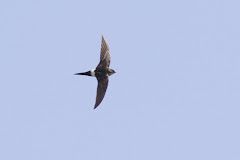


The earliest Easter for over 100 years was also one of the coldest I can remember, including heavy snowfall. I spent a few days in Yorkshire with Libby's parents before migrating south to spend Easter with my parents in Winterton, Norfolk. Saturday was one of the most inhospitable days I have ever experienced in Winterton with a bitter and strong north-easterly wind battering the coast, coinciding with a high tide. I was determined to do some birding and I was rewarded early with a genuine HOODED CROW in the horse paddocks - a scarce bird in east Norfolk (we do have at least two hybrids regularly wintering between Winterton and Horsey but a "real" Hoodie is rare). As I ventured north the sea was pounding against the sea-wall between the village and Horsey and, for some reason, I thought it might produce some good sea-watching. A few Gannets, Fulmars and Red-throated Divers didn't do enough to keep me there for long, though, and after I received an exfoliating sand-blasting that you'd pay good money for in a spa..(!), I soon retired to the relative shelter of the west side of the dunes to scour the area in the vain hope of an early migrant or two. It wasn't long before I gave up and wandered back, wind-assisted, to a cup of tea and a piece of homemade cake! Sunday was much better, at least initially, and the sunny early morning produced a FIRECREST along Low Road and, shortly afterwards, the highlight for me - a SLAVONIAN GREBE - on the sea off the cafe at the beach car park. Tim showed up about half an hour later but by then the grebe had drifted south.. There was some compensation in the form of a first-winter MEDITERRANEAN GULL feeding in the surf. After a break during several hours of heavy snowfall, the day later produced SHORT-EARED OWL (thanks Peter!) and the first real summer migrant of the year in the form of a NORTHERN WHEATEAR (Peter again, unfortunately not seen by me). Tim then found a cracking male BLACK REDSTART in the allotments - always a very welcome sight. I finished the weekend on 86 species for my Winterton year-list so far, not including the PURPLE SANDPIPER that frustratingly inhabited the reefs just north of the parish. Nevertheless, it did pose well for photographs with the accompanying Grey Seals... Poor old Sean was due to spend Easter on the Isles of Scilly but, as of Sunday, hadn't made it due to the cancellation of the RMV Scillonian crossing due to high winds - I certainly wouldn't want to do that journey in bad weather - it's bad enough on a flat calm sea! It was good to see Ted out and about, too, and he had a tantalising glimpse of what was almost certainly another rarity for Winterton in the form of a WATER RAIL on the duckpond.. Nice one Ted!
As usual, a thoroughly enjoyable trip back!








